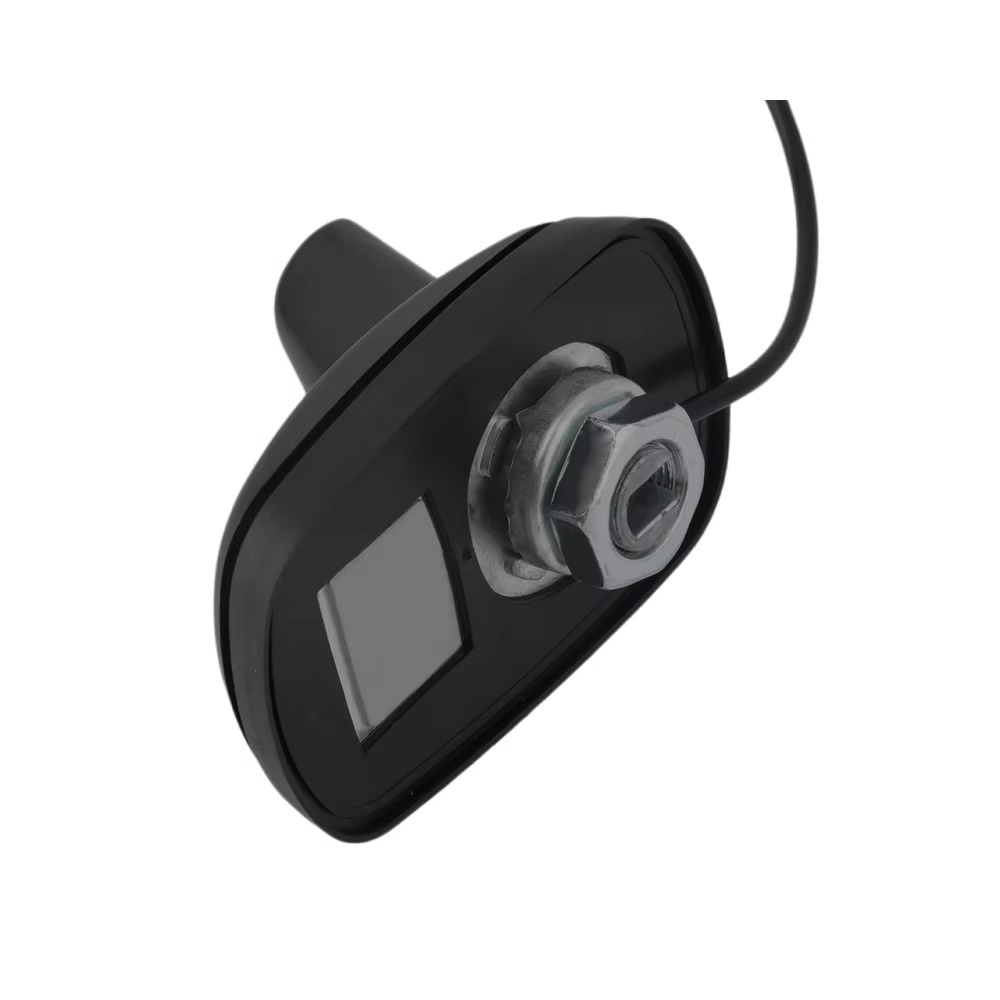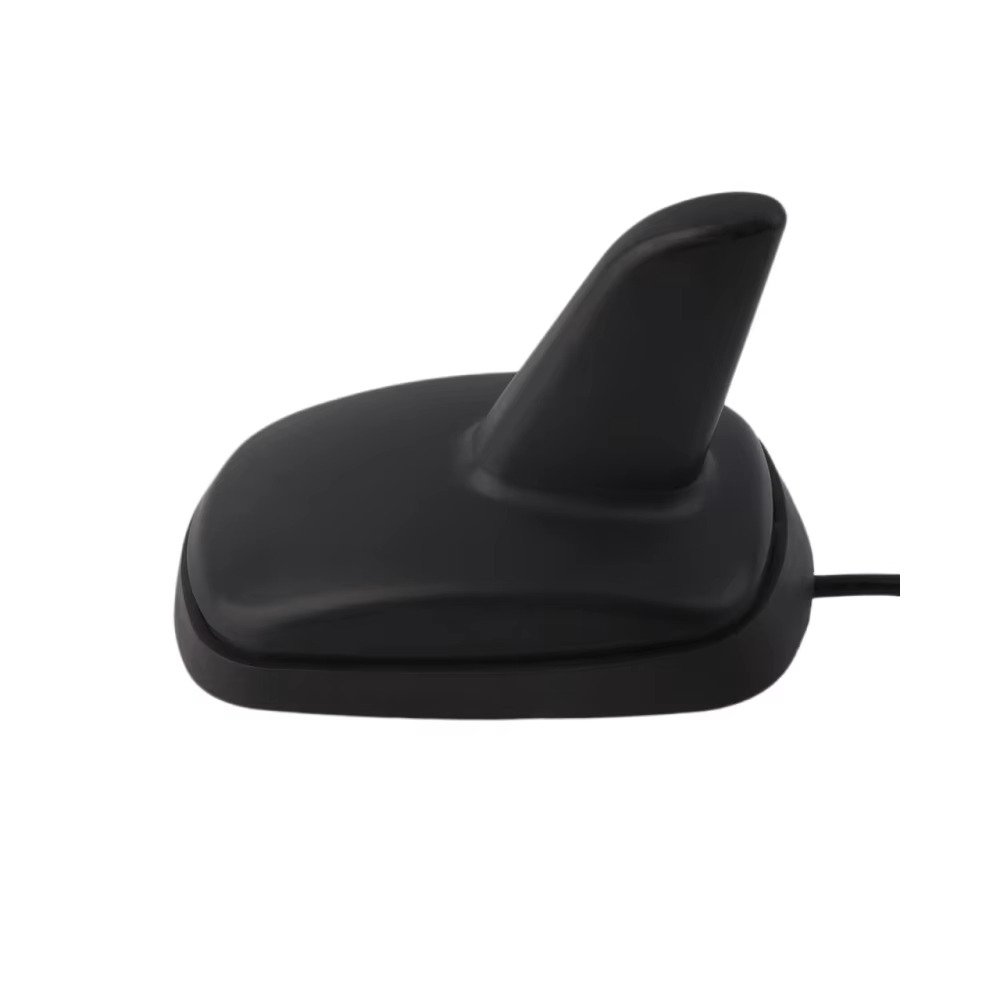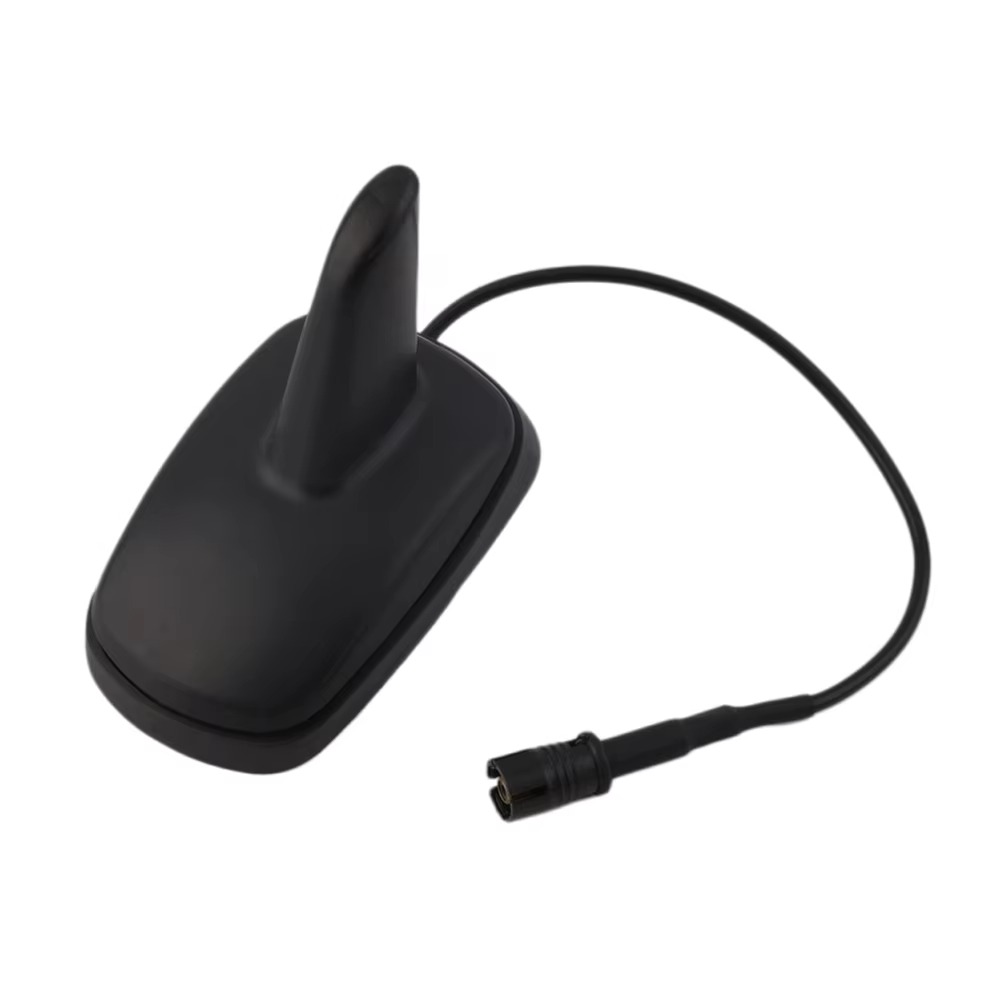Design and Aesthetics: Merging Form and Function
The shark fin antenna derives its name from its distinct shape, which closely resembles the dorsal fin of a shark. This design is no mere coincidence; it is the result of extensive research into aerodynamics, aesthetics, and practicality. Traditional whip antennas, while functional, were prone to damage from low-hanging branches, car washes, and high-speed winds. They also disrupted the vehicle’s aerodynamic profile, contributing to increased fuel consumption and wind noise. The shark fin antenna addresses these issues by hugging the car roof, reducing wind resistance and minimizing the risk of damage.
Crafted primarily from high-quality plastics, the shark fin antenna boasts a robust and durable exterior. The choice of plastics is deliberate, as they offer excellent resistance to harsh weather conditions, including extreme temperatures, UV radiation, and moisture. This ensures that the antenna remains functional and visually appealing even after prolonged exposure to the elements. The black color of the antenna is another thoughtful design choice, as it blends seamlessly with most car paint colors, maintaining the vehicle’s sleek and cohesive look. Unlike some aftermarket accessories that clash with the car’s design, the shark fin antenna enhances the vehicle’s aesthetic, giving it a modern and sporty appearance.
The compact size of the shark fin antenna is yet another advantage. It occupies minimal space on the car roof, leaving room for other components such as sunroofs or panoramic roofs. This space efficiency is particularly valuable in modern vehicles, where manufacturers strive to maximize interior and exterior space for comfort and functionality. Additionally, the low profile of the antenna reduces the risk of interference with garage doors or other structures, making it a practical choice for everyday use.
Core Functionality: GPS/GNSS and Beyond
At its core, the shark fin antenna is designed to facilitate reliable communication, with a primary focus on GPS (Global Positioning System) and GNSS (Global Navigation Satellite System). These systems rely on signals transmitted from satellites orbiting the Earth, which are received by the antenna and processed by the vehicle’s navigation system to determine the vehicle’s precise location, speed, and direction. The efficiency of this process depends heavily on the antenna’s ability to capture and amplify these weak satellite signals, even in challenging environments such as urban canyons, tunnels, or dense foliage.
The technical specifications of the shark fin antenna, as outlined, play a crucial role in its performance. The frequency range of 80~108 MHz is well-suited for receiving GPS/GNSS signals, which typically operate in the L-band (1-2 GHz). While the specified frequency range may seem lower, it is important to note that this could encompass other communication bands, such as those used for AM/FM radio, which are often integrated into modern shark fin antennas. This multi-band capability allows the antenna to serve multiple purposes, reducing the need for multiple antennas on the vehicle.
The antenna’s impedance of 75Ω is standard for coaxial cables used in communication systems, ensuring efficient signal transmission between the antenna and the vehicle’s receiver. A mismatch in impedance can lead to signal loss, reducing the antenna’s effectiveness. By adhering to this standard, the shark fin antenna ensures optimal signal transfer, maximizing the strength and clarity of received signals.
The voltage and current requirements of 12V and 18mA, respectively, are compatible with the electrical systems of most vehicles. This low power consumption ensures that the antenna does not place a significant burden on the vehicle’s battery or alternator, contributing to overall energy efficiency. The use of a copper signal line further enhances signal transmission, as copper is an excellent conductor of electricity, minimizing signal loss and interference.
Technical Performance: Gain, Noise, and Reliability
The performance of any antenna is measured by its ability to amplify desired signals while minimizing noise and interference. The shark fin antenna excels in this regard, with a profit (gain) of 25dB. Gain refers to the antenna’s ability to focus its radiation pattern in a specific direction, thereby increasing the strength of received signals. A gain of 25dB is substantial, indicating that the antenna is highly effective at capturing weak satellite signals and amplifying them for processing by the vehicle’s navigation system. This is particularly important in areas with poor satellite visibility, where a higher gain can mean the difference between a reliable navigation fix and a loss of signal.
Complementing its high gain is the antenna’s low noise factor of 2. The noise factor measures the amount of noise introduced by the antenna into the signal chain, with a lower value indicating better performance. A noise factor of 2 means that the antenna adds minimal noise to the received signals, ensuring that the signal-to-noise ratio remains high. This is critical for accurate navigation, as noise can distort signals and lead to errors in position calculation. By maintaining a low noise factor, the shark fin antenna ensures that the navigation system receives clean, reliable signals, resulting in precise and consistent positioning.
The reliability of the shark fin antenna is further enhanced by its reinforced copper connections and waterproof knife fuse holder. The reinforced copper connections ensure a secure and stable electrical connection between the antenna and the vehicle’s receiver, reducing the risk of signal loss due to loose or corroded connections. This is especially important in vehicles, which are subject to constant vibration and movement that can loosen connections over time. The waterproof knife fuse holder adds an extra layer of protection, safeguarding the antenna’s electrical components from moisture and water damage. This is crucial for maintaining functionality in wet weather conditions, such as rain or snow, where water intrusion could otherwise render the antenna inoperative.
The inclusion of electronic components and metal in the antenna’s construction contributes to its overall performance and durability. Electronic components, such as amplifiers and filters, are integrated into the antenna to further enhance signal strength and reduce interference. These components work in tandem with the antenna’s physical design to ensure that only desired signals are amplified, while unwanted noise and interference are filtered out. Metal components, such as the antenna’s internal elements, provide structural support and help shape the antenna’s radiation pattern, optimizing its ability to capture signals from satellites.
Environmental Resistance: Withstanding the Elements
Vehicles operate in a wide range of environmental conditions, from scorching deserts to freezing tundras, and from humid rainforests to dusty deserts. The shark fin antenna is designed to withstand these extremes, thanks to its high-quality materials and robust construction. The plastic exterior is resistant to UV radiation, preventing fading and degradation over time. This ensures that the antenna retains its black color and structural integrity, even after years of exposure to sunlight.
The waterproof knife fuse holder and sealed connections protect the antenna’s internal components from moisture, preventing corrosion and electrical shorts. This is particularly important in regions with high rainfall or humidity, where water damage can significantly reduce the lifespan of electronic components. The antenna’s resistance to temperature extremes is another key feature, allowing it to operate reliably in both hot and cold climates. Whether parked in the sun on a summer day or exposed to sub-zero temperatures in winter, the shark fin antenna maintains its performance, ensuring uninterrupted navigation.
Dust and debris resistance is also a critical consideration, especially for vehicles driven in off-road conditions or in areas with high levels of air pollution. The shark fin antenna’s sealed design prevents dust and debris from entering its internal components, reducing the risk of damage and ensuring consistent performance. This durability makes the antenna a reliable choice for a wide range of vehicles, from daily commuters to rugged off-road vehicles.
Integration with Modern Vehicle Systems
Modern vehicles are equipped with a wide array of advanced systems, including infotainment, telematics, and driver assistance systems, all of which rely on reliable communication. The shark fin antenna serves as a central hub for these systems, providing connectivity for GPS navigation, AM/FM radio, satellite radio, and even cellular and Wi-Fi signals in some models. This integration eliminates the need for multiple antennas, reducing clutter on the vehicle’s roof and simplifying the manufacturing process.
In navigation systems, the shark fin antenna’s high gain and low noise factor ensure that the vehicle’s position is updated frequently and accurately, even in challenging environments. This is essential for features such as real-time traffic updates, lane guidance, and points of interest, which depend on precise location data. For driver assistance systems, such as adaptive cruise control and lane-keeping assist, reliable GPS signals help the vehicle maintain a safe distance from other vehicles and stay within its lane, enhancing overall safety.
The antenna’s compatibility with AM/FM radio ensures that drivers can enjoy their favorite radio stations without interference, thanks to its efficient signal reception and filtering capabilities. In vehicles equipped with satellite radio, the shark fin antenna captures satellite signals, providing access to a wide range of channels with crystal-clear sound quality. For telematics systems, which enable features such as remote vehicle monitoring, emergency assistance, and stolen vehicle tracking, the antenna’s reliable connectivity ensures that these services are always available when needed.
Advantages Over Traditional Antennas
The shark fin antenna offers numerous advantages over traditional whip antennas, making it the preferred choice for modern vehicles. One of the most significant advantages is its aerodynamic design, which reduces wind resistance and drag. This not only improves fuel efficiency but also reduces wind noise, creating a quieter and more comfortable driving experience. Traditional whip antennas, with their tall, exposed design, are prone to catching wind, creating turbulence and increasing fuel consumption. The shark fin antenna’s low profile eliminates this issue, contributing to the vehicle’s overall efficiency.
Durability is another key advantage. Traditional antennas are vulnerable to damage from impact with objects such as tree branches, garage doors, or other vehicles. The shark fin antenna’s compact, roof-hugging design minimizes this risk, ensuring a longer lifespan and reducing the need for repairs or replacements. Additionally, the use of high-quality materials and sealed connections makes the shark fin antenna more resistant to environmental damage, such as corrosion from moisture or UV degradation.
Aesthetics also play a significant role in the popularity of the shark fin antenna. Traditional whip antennas are often seen as unsightly, detracting from the vehicle’s sleek design. The shark fin antenna, with its modern, streamlined shape and black color, blends seamlessly with the vehicle’s roof, enhancing its visual appeal. This has made it a sought-after feature among car buyers, who value both form and function.
Multi-functionality is yet another advantage. Unlike traditional antennas, which are often dedicated to a single function (such as AM/FM radio), the shark fin antenna can support multiple communication technologies, including GPS, satellite radio, and cellular signals. This versatility reduces the number of antennas needed on the vehicle, simplifying the design and reducing costs.
Future Developments and Innovations
-
As vehicle technology continues to advance, the shark fin antenna is poised to evolve alongside it. One area of development is the integration of 5G connectivity, which will enable faster data transfer and support new features such as autonomous driving, vehicle-to-vehicle communication, and high-definition streaming. The shark fin antenna’s multi-band capability makes it well-suited to support 5G signals, which operate in both low and high frequency bands.
Another area of innovation is the use of advanced materials, such as carbon fiber, to further reduce the antenna’s weight and improve its durability. Carbon fiber is lighter than plastic and offers excellent strength and resistance to environmental damage, making it an ideal material for future antenna designs. Additionally, advancements in antenna technology, such as MIMO (Multiple Input Multiple Output) systems, which use multiple antennas to improve signal quality and data throughput, could be integrated into shark fin designs to enhance performance.
The integration of artificial intelligence (AI) into antenna systems is another potential development. AI could be used to dynamically adjust the antenna’s radiation pattern, optimizing signal reception based on real-time conditions such as satellite positions, weather, and terrain. This would further improve the antenna’s performance and reliability, ensuring consistent connectivity in all situations.
Conclusion
-
The shark fin antenna represents a perfect fusion of form and function, offering a sleek, aerodynamic design that enhances a vehicle’s aesthetics while delivering superior performance in terms of signal reception, reliability, and versatility. Its high gain, low noise factor, and robust construction make it an essential component of modern vehicle communication systems, supporting GPS/GNSS navigation, radio, and emerging technologies such as 5G and telematics.
With its resistance to environmental damage, compatibility with multiple communication bands, and integration with advanced vehicle systems, the shark fin antenna is more than just an antenna—it is a critical enabler of the connected car experience. As technology continues to advance, the shark fin antenna will undoubtedly play an even more significant role in shaping the future of automotive communication, ensuring that vehicles remain connected, safe, and efficient for years to come.




































































 Language
Language
 En
En Cn
Cn Korean
Korean

 Home >
Home > 







 18665803017 (Macro)
18665803017 (Macro)













